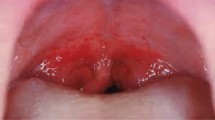Abstract
The preclinical curriculum of the Western Michigan University Homer Stryker M.D. School of Medicine was designed to provide students with a strong basic science foundation to support clinical reasoning and decision making. Courses were collaboratively developed by teams of basic science and clinical faculty to maximize integration across disciplines and across time in order to support synthesis and learning in context. Here we describe the design and implementation of Foundations of Immunology and Infectious Disease, a five-week course for first year medical students that integrates immunology, microbiology, and core concepts of infectious disease. Within this framework, relevant aspects of pharmacology, anatomy, histology, pathology, genetics, and medical ethics are embedded to promote learner synthesis, application, and retention of material.

Similar content being viewed by others
References
Brauer DG, Ferguson KJ. The integrated curriculum in medical education: AMEE guide no. 96. Med Teach. 2015;37(4):312–22. doi:10.3109/0142159X.2014.970998.
Roberts DH, Newman LR, Schwartzstein RM. Twelve tips for facilitating millennials’ learning. Med Teach. 2012;34(4):274–8. doi:10.3109/0142159X.2011.613498.
Michaelsen LK, Watson WE, Cragin JP, Fink LD. Team-based learning: a potential solution to the problems of large classes. Exch Organ Behav Teach J. 1982;7(4):18–33.
Mayer R. The Cambridge handbook of multimedia learning. New York: Cambridge University Press; 2005.
Mayer RE. Applying the science of learning to medical education. Med Educ. 2010;44(6):543–9. doi:10.1111/j.1365-2923.2010.03624.x.
Smith JM, McClelland EE. Teaching immunology through microbiology. Med Sci Educ. 2014;22(3):96–101. doi:10.1007/bf03341768.
Bandiera G, Boucher A, Neville A, Kuper A, Hodges B. Integration and timing of basic and clinical sciences education. Med Teach. 2013;35(5):381–7. doi:10.3109/0142159X.2013.769674.
Bernstein B. Pedagogy, symbolic control and identity: theory, research, critique. London: Rowman and Littlefield; 2000.
Papa FJ, Harasym PH. Medical curriculum reform in North America, 1765 to the present: a cognitive science perspective. Acad Med. 1999;74(2):154–64.
McLaren DS. What to do about basic medical science. Br Med J. 1980;281(6233):171–2.
Prince KJ, Van De Wiel M, Scherpbier AJ, Can Der Vleuten CP, Boshuizen HP. A qualitative analysis of the transition from theory to practice in undergraduate training in a PBL-medical school. Adv Health Sci Educ Theory Pract. 2000;5(2):105–16. doi:10.1023/A:1009873003677.
Blake RL, Hosokawa MC, Riley SL. Student performances on step 1 and step 2 of the United States medical licensing examination following implementation of a problem-based learning curriculum. Acad Med. 2000;75(1):66–70.
Loftus S. Understanding integration in medical education. Med Sci Educ. 2015;25(3):357–60. doi:10.1007/s40670-015-0152-4.
de Bruin AB, Schmidt HG, Rikers RM. The role of basic science knowledge and clinical knowledge in diagnostic reasoning: a structural equation modeling approach. Acad Med. 2005;80(8):765–73.
Snyman WD, Kroon J. Vertical and horizontal integration of knowledge and skills - a working model. Eur J Dent Educ. 2005;9(1):26–31. doi:10.1111/j.1600-0579.2004.00355.x.
Vidic B, Weitlauf HM. Horizontal and vertical integration of academic disciplines in the medical school curriculum. Clin Anat. 2002;15(3):233–5. doi:10.1002/ca.10019.
Woods NN. Science is fundamental: the role of biomedical knowledge in clinical reasoning. Med Educ. 2007;41(12):1173–7. doi:10.1111/j.1365-2923.2007.02911.x.
Cooke M, Irby DM, Sullivan W, Ludmerer KM. American medical education 100 years after the Flexner report. N Engl J Med. 2006;355(13):1339–44. doi:10.1056/NEJMra055445.
Woods NN, Brooks LR, Norman GR. It all make sense: biomedical knowledge, causal connections and memory in the novice diagnostician. Adv Health Sci Educ Theory Pract. 2007;12(4):405–15. doi:10.1007/s10459-006-9055-x.
Woods NN, Howey EH, Brooks LR, Norman GR. Speed kills? Speed, accuracy, encapsulations and causal understanding. Med Educ. 2006;40(10):973–9. doi:10.1111/j.1365-2929.2006.02556.x.
Schmidt HG, Boshuizen HP. On the origin of intermediate effects in clinical case recall. Mem Cogn. 1993;21(3):338–51.
Schmidt HG, Rikers RM. How expertise develops in medicine: knowledge encapsulation and illness script formation. Med Educ. 2007;41(12):1133–9. doi:10.1111/j.1365-2923.2007.02915.x.
Biron CA, Casadevall A. On immunologists and microbiologists: ground zero in the battle for interdisciplinary knowledge. MBio. 2010;1(5):e00280. doi:10.1128/mBio.00260-10.
Norman G. The essential role of basic sciences in medical education: the perspective from psychology. Clin Invest Med. 2003;23:47.
Grande JP. Training of physicians for the twenty-first century: role of the basic sciences. Med Teach. 2009;31(9):802–6.
Cepeda NJ, Pashler H, Vul E, Wixted JT, Rohrer D. Distributed practice in verbal recall tasks: a review and quantitative synthesis. Psychol Bull. 2006;132(3):354–80. doi:10.1037/0033-2909.132.3.354.
Wixted JT. On common ground: Jost’s (1897) law of forgetting and Ribot’s (1881) law of retrograde amnesia. Psychol Rev. 2004;111(4):864–79. doi:10.1037/0033-295X.111.4.864.
Acknowledgments
The authors wish to thank Dr. Laura Bauler for critical reading of this manuscript and the members of the Foundations of Immunology and Infectious Disease course committee who helped to design this course and participated in its delivery: Kelly Quesnelle, PhD, Andrew Morris, PhD, and Hal Jenson, MBA, MD.
Author information
Authors and Affiliations
Corresponding author
Rights and permissions
About this article
Cite this article
Bauler, T.J., Shattuck, B., Van Enk, R. et al. Design and Implementation of an Integrated Course to Teach Immunology and Infectious Disease to First Year Medical Students. Med.Sci.Educ. 26, 701–707 (2016). https://doi.org/10.1007/s40670-016-0300-5
Published:
Issue Date:
DOI: https://doi.org/10.1007/s40670-016-0300-5




